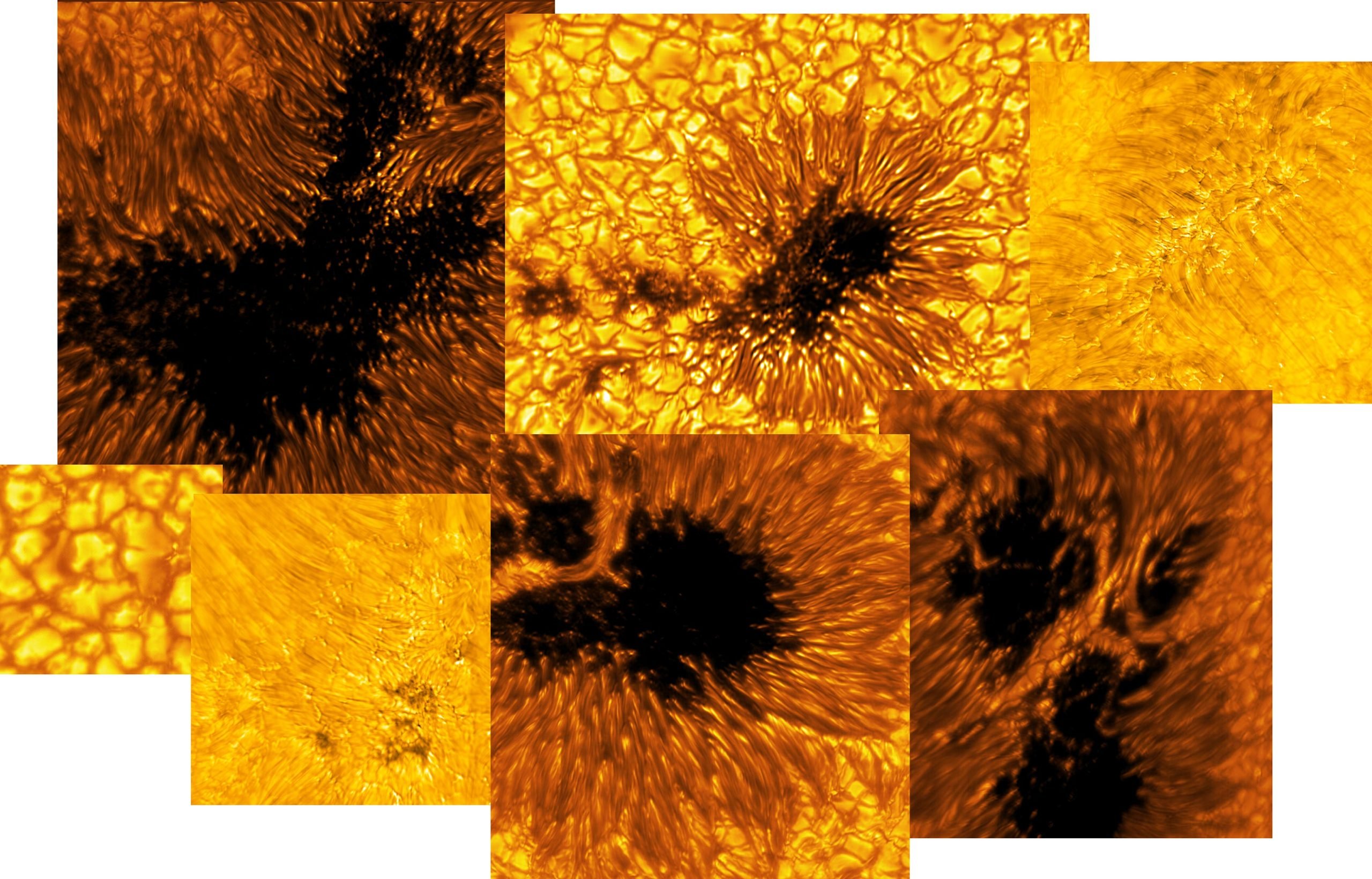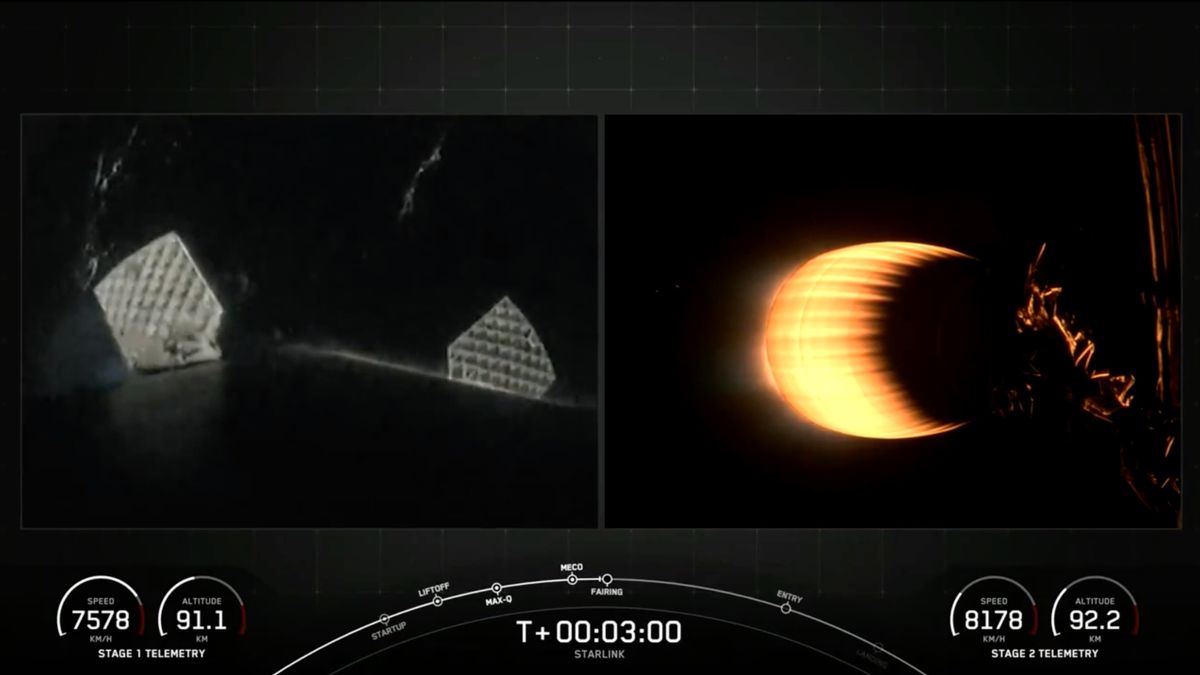
تم إصدار فسيفساء من الصور الشمسية الجديدة التي تم إنتاجها بواسطة Inouye Solar Telescope ، لمعاينة البيانات الشمسية التي تم التقاطها خلال السنة الأولى من تشغيل التلسكوب أثناء مرحلة التشغيل. تشمل الصور البقع الشمسية وملامح الشمس الهادئة. الائتمان: NSF / AURA / NSO
نظرة عامة على البيانات الأولى لتلسكوب Inouye Solar Telescope التي تم الحصول عليها خلال نافذة المراقبة من الدورة الأولى ، والتي تتميز بالبقع الشمسية والمناطق الهادئة من الشمس
أصدر Inouye Solar Telescope التابع لمؤسسة NSF صورًا جديدة عالية الدقة للشمس ، تُظهر البقع الشمسية والمناطق الهادئة. تسلط الصور ، التي تم الحصول عليها خلال نافذة عمليات الدورة الأولى في عام 2022 ، الضوء على قدرة التلسكوب على التقاط تفاصيل شمسية غير مسبوقة ، مما يساعد العلماء على فهم المجال المغناطيسي للشمس والعواصف الشمسية.
أصدر تلسكوب دانييل كيه إنوي الشمسي التابع لمؤسسة العلوم الوطنية (NSF) ثماني صور جديدة للشمس ، مما يوفر نظرة ثاقبة للعلم المثير الذي يتم إجراؤه في أقوى تلسكوب شمسي أرضي في العالم. تتميز الصور بمجموعة متنوعة من البقع الشمسية والمناطق الهادئة للشمس التي تم الحصول عليها بواسطة Visible Broadband Imager (VBI) ، أحد أدوات الجيل الأول للتلسكوب.
إن القدرة الفريدة لتلسكوب Inouye Solar Telescope على التقاط البيانات بتفاصيل غير مسبوقة ستساعد علماء الشمس على فهم المجال المغناطيسي للشمس ومحركات العواصف الشمسية بشكل أفضل.

يوجد الغلاف الجوي السفلي (الكروموسفير) للشمس فوق سطح الشمس (الفوتوسفير). في هذه الصورة ، تظهر الخيوط الداكنة الدقيقة (الألياف) في الكروموسفير المنبثقة من مصادر في الغلاف الضوئي – ولا سيما المسام الداكنة / شظايا المظلة وبنيتها الدقيقة. المسام هو تركيز المجال المغناطيسي حيث لا تتحقق الشروط لتشكيل ظلمة. المسام هي في الأساس بقع شمسية لم يكن بها أو لن يكون لها ظل. Penumbra: المنطقة المحيطة الأكثر سطوعًا لظل البقع الشمسية التي تتميز بتركيبات خيطية لامعة. عنوان الصورة: مسام / شظايا ظلة ، ليفية وهياكل دقيقة أخرى في الغلاف الجوي وسطح الشمس PID: PID_1_16 مجال رؤية كبير: 30720 كم × 30720 كم. الائتمان: NSF / AURA / NSO معالجة الصور: Friedrich Wöger (NSO) ، Catherine Fischer (NSO) الائتمان العلمي: Juan Martínez-Sykora (Bay Area Environmental Research Institute)

في هذه الصورة ، يتم توضيح الطبيعة الليفية للغلاف الجوي الشمسي. توجد الخيوط الدقيقة الداكنة (الألياف) في كل مكان في الكروموسفير. الخطوط العريضة للهياكل المضيئة هي توقيع وجود المجالات المغناطيسية في الغلاف الضوئي أدناه. تم التقاط هذه الصورة بواسطة تلسكوب Inouye Solar Telescope أثناء حملة مراقبة منسقة مع Parker Solar Probe التابع لناسا والمركبة الشمسية التابعة لوكالة الفضاء الأوروبية ESA. الائتمان: NSF / AURA / NSO
البقع الشمسية المصورة هي مناطق مظلمة وباردة من “سطح” الشمس ، تسمى الغلاف الضوئي ، حيث توجد مجالات مغناطيسية قوية. تختلف البقع الشمسية في الحجم ، ولكن غالبًا ما يكون الكثير منها بحجم الأرض ، إن لم يكن أكبر. يمكن أن تكون البقع الشمسية المعقدة أو مجموعات البقع الشمسية مصدرًا للأحداث المتفجرة مثل التوهجات والانبعاثات الكتلية الإكليلية التي تولد عواصف شمسية. تؤثر هذه الظواهر النشطة والانفجارية على الطبقة الخارجية من الغلاف الجوي للشمس ، الغلاف الشمسي ، مع إمكانية التأثير على الأرض والبنية التحتية الحيوية لدينا.

في هذه الصورة ، يُلاحظ الهيكل الدقيق للشمس الهادئة على سطحها أو الغلاف الضوئي. ترتفع البلازما الساخنة في “الفقاعات” المضيئة والحمل الحراري (الحبيبات) ثم تبرد وتسقط في المسارات الحبيبية المظلمة. ضمن هذه المسارات بين الخلايا الحبيبية ، يتم ملاحظة الهياكل الساطعة ، مما يشير إلى مظاهر أو توقيعات المجال المغناطيسي. يساعد تلسكوب Inouye الشمسي على اكتشاف هذه العناصر المغناطيسية “الصغيرة” بتفصيل كبير. عنوان الصورة: الحبيبات الشمسية والمسارات الحبيبية والعناصر المغناطيسية للشمس الصامتة PID: PID_1_49 مجال الرؤية الكبير: 30720 كم × 30720 كم. الائتمان: NSF / AURA / NSO Image Processing: Friedrich Wöger (NSO) ، Catherine Fischer (NSO)

يمكن التعرف على البقعة الشمسية من خلال ظلتها المركزية المظلمة والظلمة الخيطية المحيطة بها. يكشف الفحص الدقيق عن وجود شظايا أمبرال قريبة – بشكل أساسي ، بقعة شمسية فقدت ظلها. كانت هذه الشظايا في السابق جزءًا من البقعة الشمسية القريبة ، مما يشير إلى أن هذه يمكن أن تكون “المرحلة النهائية” لتطور البقع الشمسية. على الرغم من أن هذه الصورة تُظهر وجود شظايا مظلية ، إلا أنه من النادر للغاية التقاط عملية تكوين أو تحلل الظلال. الظل: منطقة مركزية مظلمة من بقعة شمسية حيث يكون المجال المغناطيسي أقوى. Penumbra: المنطقة المحيطة الأكثر سطوعًا لظل البقع الشمسية التي تتميز بتركيبات خيطية لامعة. عنوان الصورة: تشير شظايا المظلة إلى “المرحلة النهائية” للبقع الشمسية PID: PID_1_22 مجال رؤية كبير: 30.720 كم × 30.720 كم. الائتمان: NSF / AURA / NSO Image Processing: Friedrich Wöger (NSO) ، Catherine Fischer (NSO) الائتمان العلمي: Jaime de la Cruz Rodriguez (Stockholm University)
في المناطق الهادئة من الشمس ، تُظهر الصور خلايا الحمل الحراري في الغلاف الضوئي تعرض نمطًا ساطعًا من الجسيمات الساخنة الصاعدة.[{” attribute=””>plasma (granules) surrounded by darker lanes of cooler, down-flowing solar plasma. In the atmospheric layer above the photosphere, called the chromosphere, we see dark, elongated fibrils originating from locations of small-scale magnetic field accumulations.

A light bridge is seen crossing a sunspot’s umbra from one end of the penumbra to the other. Light bridges are believed to be the signature of the start of a decaying sunspot, which will eventually break apart. Light bridges are very complex, taking different forms and phases. It is unknown how deep these structures form. This image shows one example of a light bridge in remarkable detail. Umbra: Dark, central region of a sunspot where the magnetic field is strongest. Penumbra: The brighter, surrounding region of a sunspot’s umbra characterized by bright filamentary structures. Image Title: A Light Bridge Captured in a Sunspot PID: PID_1_50 Large Field of View: 30,720km x 30,720km. Credit: NSF/AURA/NSO Image Processing: Friedrich Wöger(NSO), Catherine Fischer (NSO) Science Credit: Tetsu Anan (NSO)

A detailed example of a light bridge crossing a sunspot’s umbra. In this picture, the presence of convection cells surrounding the sunspot is also evident. Hot solar material (plasma) rises in the bright centers of these surrounding “cells,” cools off, and then sinks below the surface in dark lanes in a process known as convection. The detailed image shows complex light bridge and convection cell structures on the Sun’s surface or photosphere. Light bridge: A bright solar feature that spans across an umbra from one penumbra to the other. It is a complex structure, taking different forms and phases, and is believed to be the signature of the start of a decaying sunspot. Umbra: Dark, central region of a sunspot where the magnetic field is strongest. Image Title: Properties of Convection Cells and Light Bridge Seen Around a Sunspot PID: PID_1_29 Large Field of View: 30,720km x 30,720km. Credit: NSF/AURA/NSO Image Processing: Friedrich Wöger(NSO), Catherine Fischer (NSO) Science Credit: Philip Lindner at Leibniz-Institut für Sonnenphysik (KIS)
The recently inaugurated telescope is in its Operations Commissioning Phase (OCP), a learning and transitioning period during which the observatory is slowly brought up to its full operational capabilities.
The international science community was invited to participate in this phase through an Operations Commissioning Phase Proposal Call. In response to these calls, investigators submitted science proposals requesting telescope time for a specific and detailed science goal. In order to optimize for science return, while balancing the available observing time and the technical needs in this very early operational phase, the proposals were subsequently peer-reviewed by a proposal review committee and telescope time was granted by a Telescope Allocation Committee. The selected proposals were executed in 2022 during the Cycle 1 operations window.

This image reveals the fine structures of a sunspot in the photosphere. Within the dark, central area of the sunspot’s umbra, small-scale bright dots, known as umbral dots, are seen. The elongated structures surrounding the umbra are visible as bright-headed strands known as penumbral filaments. Umbra: Dark, central region of a sunspot where the magnetic field is strongest. Penumbra: The brighter, surrounding region of a sunspot’s umbra characterized by bright filamentary structures. Image Title: Sunspot Umbral Dots and Penumbral Filaments in Detail PID: PID_1_27 Large Field of View: 30,720km x 30,720km. Credit: NSF/AURA/NSO Image Processing: Friedrich Wöger(NSO), Catherine Fischer (NSO) Science Credit: Rolf Schlichenmaier at Leibniz-Institut für Sonnenphysik (KIS)

This image, taken by Inouye Solar Telescope in coordination with the ESA’s Solar Orbiter, reveals the fibrillar nature of the solar atmosphere. In the atmosphere, or chromosphere, fine, dark threads of plasma (fibril) are visible emanating from the magnetic network below. The outline of bright structures are signature of the presence of magnetic fields. Image Title: The Fibrillar Nature of the Solar Atmosphere PID: PID_1_123 Large Field of View: 30,720km x 30,720km. Credit: NSF/AURA/NSO Image Processing: Friedrich Wöger(NSO), Catherine Fischer (NSO) Science Credit: Public DDT Data
The newly released images make up a small fraction of the data obtained from the first Cycle. The Inouye Solar Telescope’s Data Center continues to calibrate and deliver data to the scientists and public.
As the Inouye Solar Telescope continues to explore the Sun, we expect more new and exciting results from the scientific community – including spectacular views of our solar system’s most influential celestial body.

“هواة الإنترنت المتواضعين بشكل يثير الغضب. مثيري الشغب فخور. عاشق الويب. رجل أعمال. محامي الموسيقى الحائز على جوائز.”





